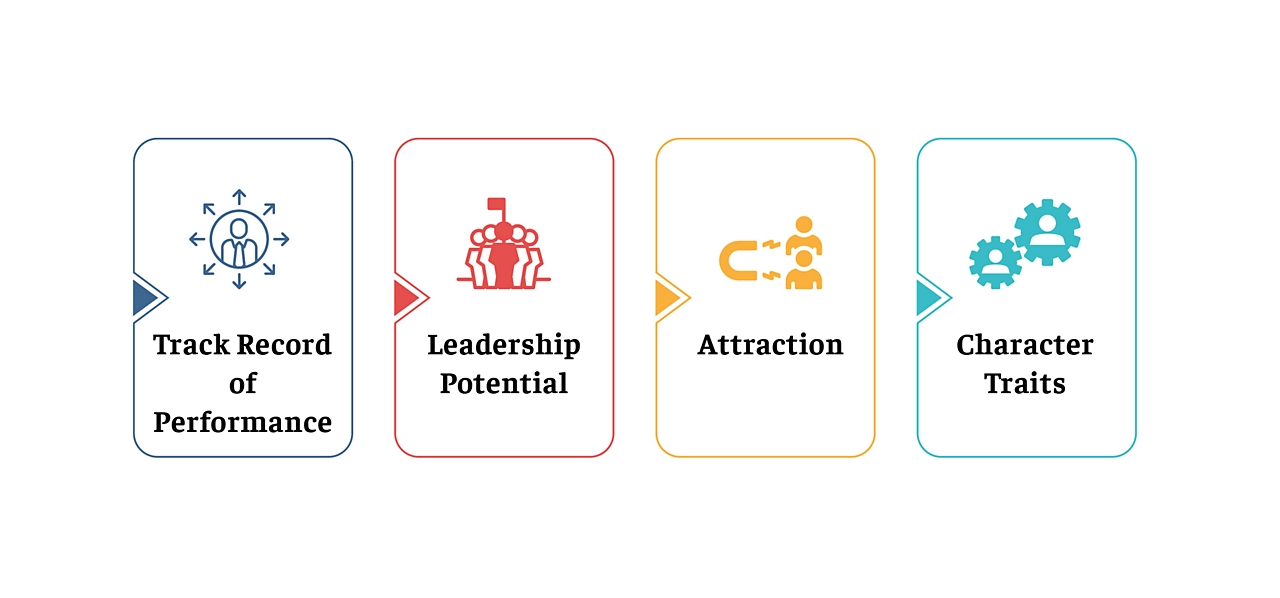Why Sponsors Sponsor
Power Up the Corporate Ladder: Find a Sponsor
By Jovina Ang, Managing Director, Communicatio |Mar 01, 2022
Career sponsors are vital allies who contribute to a leader's success. The higher one rises through the ranks of an organisation, the more the need to have an influential advocate who bats for you when you are not in the room. In this article, Jovina Ang, a former award-winning corporate leader, talks about her experience and research in career sponsorship and its crucial role in helping leaders progress to the top of their fields.
Many believe that success is a combination of hard work and getting the right opportunities at the right time. Leaders worldwide often credit getting such opportunities to others who encouraged them, sponsored them, and helped them grow. The corporate world is rife with stories and examples where leaders of today reflect on the people who made a pivotal career break of yesterday possible for them through career sponsorship.
Sheryl Sandberg, Chief Operating Officer of Facebook, catapulted her career to new heights after being sponsored by Lawrence Summers, her thesis advisor and Economics professor at Harvard University. Summers supported her, providing her various opportunities, ultimately leading her to top positions at Google and Facebook.[1] Christin Wiedemann, President of Radical I/O, a software development consultancy in Canada, credits much of her success to her sponsor, Namir Anani, President and CEO of the Information and Communications Technology Council. Anani helped Wiedeman widen her network and hone her leadership skills.[2] In both these examples, the leaders, although capable in their own right, got exposed to new opportunities by being sponsored by senior leaders during their careers.
Cognisant of the value it adds, several organisations have launched formal sponsorship programmes connecting senior leaders with high-potential employees, such as Deutsche Bank's ATLAS (Accomplished Top Leaders Advancement Strategies) programme. In Microsoft, employees of grades 66 and above have the opportunity of formal sponsorship. American Express, Cisco, and Deloitte are a few other organisations that have formulated policies for sponsorship.[3] The Protégé Project is a cross-country sponsorship programme in Canada at the industry level.[4] Launched in 2014, the programme has seen much success in advancing women to the top of the corporate ladder.
Such anecdotes are not unique and unheard of. It is, therefore, essential to take a closer look at career sponsorship.
Career Sponsorship—The Helping Hand
Career sponsorship is a development relationship between a sponsor and a sponsee, or a protégé, that helps one move up the corporate ladder. Roles at the top of the corporate hierarchy are far and few. Hence, the higher you progress, the more sponsorship matters. A good sponsor goes all-out—advocates on the sponsee's behalf, pushes their proposals forward, connects them to influential networks, and provides career progression opportunities. They are vested and committed to their sponsee's success and development.
However, there are marked differences between a sponsor, a mentor, and a coach. A coach helps an individual get better at something and develop specific skills. While mentors advise as they know the pitfalls a mentee may go through. I see a sponsor in its formal definition as the one who culminates it all–a coach, plus mentor, and more. A sponsor would sit at the highest level of the hierarchy of roles. He or she is someone who stands up publicly for the individual in whom they believe, and thus, would push forward with the individual to secure the next big role.
When I was at Microsoft, my boss helped open many doors for me. He honed my skills in leading the communication function at Microsoft and took every opportunity to showcase my work to the executive team at the worldwide organisation. Through his sponsorship I was able to secure other leadership roles at Microsoft.
Value of Career Sponsorship
Organisations are incredibly cautious about whom they appoint for senior roles. Every new hire is carefully vetted and examined. If the wrong people are put in those roles, it can set the organisation a couple of steps back. Hence, sponsors need to ensure that their sponsees are reliable and safe bets. If a sponsor vouches for a candidate, one becomes a safe bet for the role. When a sponsor bats for the sponsee, the sponsor's brand is at stake, and chances are that people will listen, ultimately helping the sponsee succeed in getting ahead. And that's why sponsorship matters so much.
But there is an apparent gap between theory and practice! During my doctoral and post-doctoral research,[5] I have found that as many as 98% of polled executives and senior leaders believed that having a sponsor was beneficial to boost their careers. However, only about 55% of them had a career sponsor backing them. The polled executives also helped quantify their career progress attributable to a sponsor relationship. Almost 60% of executives believed that sponsorship helped them move one to two levels up from their current roles. As many as 30% believed that sponsorship helped them progress three levels up towards a board directorship.
The Currency of Sponsorship
A sponsor can help the sponsee build skills and knowledge and the three types of capital vital to progress. The first is agentic capital—one's identity as a leader. The second is human capital—the skills, knowledge, and experiences to do the job. The third is social capital—who you know, and more importantly, who knows you. In other words, one needs people, especially senior leaders and executives, to get exposure and visibility in the organisation.
Building social capital is arguably the trickiest of the three. Many leaders, especially women, put their heads down, do all the work, and hope to get noticed. However, without social capital, people don't necessarily tend to notice. Sponsors can help in two ways—first, to give a stretch assignment, and second, to ensure that the successful completion of the assignment is duly recognised within their sphere of influence.
Sharing a personal example, my first sponsor was my manager at Telstra, an Australian telecom company. Seeing my work ethic and commitment to excellence, he gave me a stretch role to manage a major business generating A$1.4 billion annually for Telstra. My sponsor not only taught me how to manage the business, but also gave me considerable publicity and networking prospects with the rest of Telstra management. In other words, he truly invested in my development—my human capital and social capital.
A Symbiotic Relationship
While sponsorship benefits are well established for a sponsee, what the sponsor gains from the relationship is often ambiguous. People generally become career sponsors for four reasons. First, many sponsors simply want to pay it forward to others just as someone had previously paid it forward for them. Others sponsor to fulfil their psychological needs for relatedness or building connections. Third, some possess a high level of empathy towards others and are drawn towards sponsorship.
Finally, sometimes sponsors sponsor because of a quid pro quo arrangement. These sponsors tend to view sponsorship as a transactional relationship, and they expect to get things done through their sponsees. This could entail the sponsees taking additional initiatives to help the sponsors fulfil their personal or organisational objectives. I recently came across a transactional relationship that resulted in a successful sponsor-sponsee relationship at Citibank. The managing director had just built a massive data analytics department and was ready to move on to the next role. So, he purposefully groomed and sponsored his sponsee to take over his position because he didn't want his brainchild to die or fail.
Approaching a Sponsor
To acquire and establish a successful relationship with a sponsor, one must prove to be a good investment and be trustworthy. A strong track record of performance is a must—no sponsor will invest in a dud. As senior leaders are tasked with building the talent pipeline, they also look for people with leadership potential. Because the sponsor relationship is intimate, having a sponsee with similar interests, values, outlooks, and mindset helps draw people together.
In most cases, the easiest way to find a sponsor is to make the immediate manager one's first sponsor since he or she knows the individual's capability and the value the individual brings to the organisation. If the sponsee adds value to the business and makes the manager look good, when the opportunity arises, the sponsee would often find his or her manager speaking about him or her—giving the exposure and visibility needed to get ahead.
There are also possibilities for a senior leader not in the immediate chain of command to be a sponsor. In that case, it would well serve the candidate to ask them. My doctoral research shows that some male leaders might not consider sponsoring unless formally requested. In contrast, female leaders typically would reach out to potential sponsees even though they are not asked. Also, it is easier to seek out leaders who have previously been sponsored because they view it as their way of paying it forward.
Risks and Pitfalls
People typically talk about the positive or impactful side of sponsorship. However, there can be risks, and it is crucial to be aware of these. If a sponsee fails to deliver—whether to fulfil a key performance indicator (KPI) or perform in a role—other leaders will start to question why the sponsor is investing so much in the sponsee. When this happens, the sponsor might cut off the relationship with the sponsee.
Another risk is that, as sponsees typically only have one sponsor, they are very dependent on the person. If the sponsor suddenly leaves for some reason—moves to a different country or retires—the sponsee may be left exposed with no advocate on the leadership team. This can set the sponsee back many steps, because nowadays, in most organisations, promotions and career opportunities are decided by a board of leaders and not by one person. It is, therefore, advisable to have multiple sponsors.
Sponsoring Women to Success
It is a well-known fact that female representation at the top corporate levels is meagre worldwide. Looking at the Indian context, the numbers are stark—there is one female C-suite voice compared to nine male voices. The female population in India is 48%,[6] but only 16% of the workers are female.[7] A large chunk of the female talent pool does not participate in the workforce. To make matters worse, even though women earn as many as 53% of the undergraduate degrees in India,[8] the higher one goes in management, the proportion of women lowers. At the top management level, it is only 15%, whereas women comprise only 10% and 8% of C-suite and executive board positions, respectively.[9]
At the senior levels, there are fewer jobs, and there is also more competition. Roles are rarely advertised, and often if the roles are advertised, the leadership board would have one or two candidates in mind. Hence, connections are crucial to secure positions at the top. As women's networks are not as robust and expansive as men's networks, male sponsors can help a female leader aim for the top and advance her career. Many women, especially at the individual contributor level and at the beginning of their careers, tend to work hard. However, they don't tend to progress with ease. It is no coincidence that many don't have a robust sponsor network. Once a female leader reaches director level and above, it is not just her capabilities and experience that matter; she needs to tap her network. Connecting women to powerful sponsors can provide them with the required platform to develop themselves and progress in the organisational hierarchy.
It is well established that having an equitable representation at senior leadership levels is beneficial for organisations' financial performance.[10] Therefore, more male sponsors are needed to open more doors for female leaders. Also, research has shown that men talk more than women in the workplace setting. On average, women speak for three minutes compared to men, who speak for 13 minutes.[11] So, if more male sponsors speak more about their female sponsees, their chances of getting noticed multiply. Indeed, men play a pivotal role in sponsoring their juniors, especially women.
In Conclusion
If you have the right sponsor, you move faster. It is as simple as that. Having a sponsor helps elevate an individual's brand from being 'a face in the crowd' to 'the face in the crowd.'
Hard work gets you so far, but career sponsorship can get you further. It can help others recognise your potential, shine a spotlight on your strengths and achievements, and boost your career. Sponsorship can be effective outside a formal matrixed organisation as well. Sponsors for entrepreneurs could help with funding, bagging the first client, or even endorsing what they have to offer. Even people who have collaborated in a different capacity, say, in a volunteer organisation, can be potential sponsors.
Seek your Sponsor—The Do's That Matter
- Do not have a checklist when seeking out sponsors. Show up, bring your whole self, deliver stellar performances, and exceed expectations. Don't waste your 'shots' to show up well and showcase your work; embrace every opportunity to shine and show your capability.
- Start out by asking your manager to be your sponsor. Remember, sponsorship is a two-way street; a mutually beneficial relationship—when you make your boss look good, they are more inclined to help you—whether to give you more opportunities to grow, or even tell other people, especially leaders, about you. Your success can, in turn, help further enhance your sponsor's achievements and reputation.
- Do not have only one sponsor. If your sponsor disappears, you suddenly go from 'known' to 'unknown.' To circumvent this, have a network of sponsors.
- To build a relationship, spend time and make efforts from a personal as well professional viewpoint. In the current day remote/hybrid work scenario exacerbated by the COVID-19 pandemic, we all need to show a bit of care and concern to strengthen our relationships, especially with our sponsors—a phenomenon I term as "careology." To build a strong relationship, get to know your sponsor, go above and beyond, and gain their trust and loyalty.
- When the time comes, remember to 'pay it back' by helping the sponsor, and also to 'pay it forward' by helping others.
[1] Hewlett, S. A., 2013. Mentors Are Good. Sponsors Are Better. New York Times. Retrieved from https://www.nytimes.com/2013/04/14/jobs/sponsors-seen-as-crucial-for-womens-career-advancement.html
[2] Case Study. The Protégé Project. Retrieved from https://www.wct-fct.com/sites/default/files/protege_case_study.pdf
[3] Goudreau, J., 2013. Why You Need A Sponsor – Not A Mentor – To Fast-Track Your Career. Business Insider India. Retrieved from https://www.businessinsider.in/why-you-need-a-sponsor-not-a-mentor-to-fast-track-your-career/articleshow/22442562.cms
[4] Op. cit.
[5] My doctoral research included an in-depth inductive case study qualitative research on 19 sponsors and 16 sponsees. The primary purpose of the research was to understand in detail the construct of sponsorship—what it is, why it matters, and the outcomes of career sponsorship. The follow-up research was a quantitative study to understand the incidence of sponsorship and its impact on the levels of career progression. The sample size for the follow-up research was 100 senior leaders from across the world.
[6] Population, female (% of total population) – India, electronic dataset, The World Bank, viewed date January 24, 2012, https://data.worldbank.org/indicator/SP.POP.TOTL.FE.ZS?locations=IN
[7] Kumar, M., 2021. India’s female labour participation rate falls to 16.1% as pandemic hits jobs. Reuters. Retrieved from https://www.reuters.com/world/india/indias-female-labour-participation-rate-falls-161-pandemic-hits-jobs-2021-08-03/
[8] 2020. Women in the Workforce: India (Quick Take). Catalyst. Retrieved from https://www.catalyst.org/research/women-in-the-workforce-india/
[9] Naair, D., & Anderson, C., 2021. Women, leadership, and missed opportunities: The India Perspective. IBM Institute for Business Value. Retrieved from https://www.ibm.com/thought-leadership/institute-business-value/report/women-leadership-2021-india#
[10] Dixon-Fyle, S., Dolan, K., Hunt, V., & Prince, S., 2020. Most diverse companies now more likely than ever to outperform financially. McKinsey & Company. Retrieved from https://www.mckinsey.com/featured-insights/coronavirus-leading-through-the-crisis/charting-the-path-to-the-next-normal/most-diverse-companies-now-more-likely-than-ever-to-outperform-financially
[11] Sadker, M., & Kaser, J., 1984. The Communications Gender Gap. Mid-Atlantic Center for Sex Equity, pp.2. Retrieved from https://napequity.org/wp-content/uploads/R1e-Gender-Communications-Quiz.pdf

Jovina Ang, Managing Director, Communicatio
Jovina Ang is the Managing Director of Communicatio, a privately owned consultancy. Formerly an award-winning corporate executive of multiple Fortune 500 companies, including Microsoft, Dell, and Cisco Systems, Ang launched the first inter-company mentoring programme for emerging female leaders in the Singapore IT industry. She is also a published author of three books: 'Leadership Communication: Connect. Engage. Inspire.', 'The Game Plan of Successful Career Sponsorship', and 'Building Excellence in Higher Education: Singapore's Experience'.





?fmt=avif&qlt=100,0&resMode=sharp2&op_usm=1.75,0.3,2,0)
